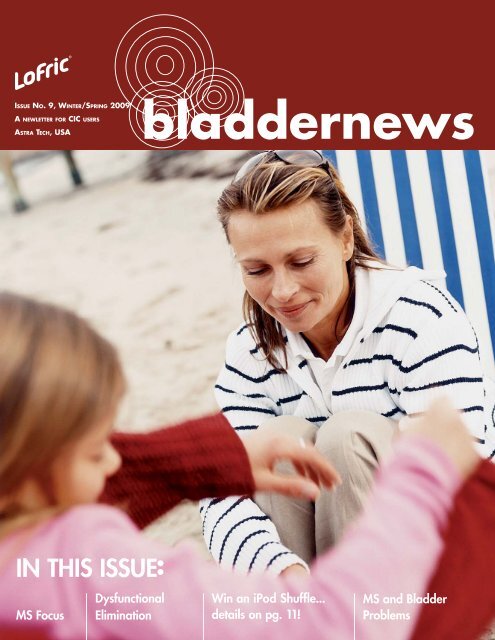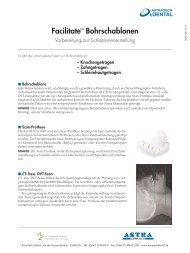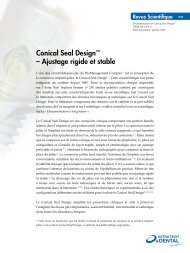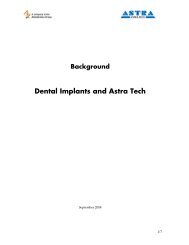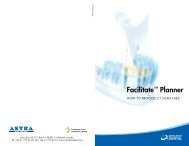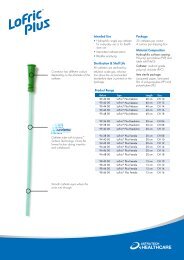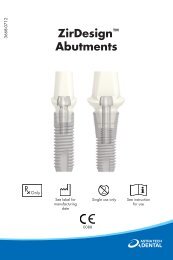Create successful ePaper yourself
Turn your PDF publications into a flip-book with our unique Google optimized e-Paper software.
laddernewsISSUE NO. 9, WINTER/SPRING 2009A NEWLETTER FOR CIC USERSASTRA TECH, USAbladdernewsIN THIS ISSUE:MS FocusDysfunctionalEliminationWin an iPod Shuffle...details on pg. 11!MS and BladderProblems
Welcome...Bladdernewsissue #9Welcome to issue #9 ofBladdernews. We wish all ourreaders a very happy andhealthy new year!In this issue, we have twofeature articles written byhealthcare professionals. Thefirst from nurse Kathy Costellotitled “Gotta Go!! MS andBladder Problems” where shefocuses on connections betweenMS and the bladder, describesbladder problems that can occurin patients with MS, and offersadvice on ways to be proactivein treatment and diagnosing.The second article is written bynurse Jake Klein who addressesthe topic of “Potty Training andDysfunctional Elimination”. Herelates how the coordination ofpotty training steps is crucialto successful voiding and theoverall establishment of optimalbladder habits.Attention all LoFric kids! We arefeaturing an exciting coloringcontest with an iPod Shuffl eand iTunes gift card grandprize! Get out your crayons andstart coloring, entries must bereceived by June 1, 2009. Thewinning picture will be featuredin our next issue, ,good luck!Happy Reading!FEATURE ARTICLE #1Gotta Go!!MS and BladderProblemsKathleen M. Costello, RN, MSNearly everyone has had atleast one occasion when theyexperienced bladder urgency– that feeling that you mustempty your bladder RIGHTNOW! Sometimes this mightoccur while on a long car ride,or on a long flight. But usuallywe do not consciously “think”about our bladder on a regularbasis.With a diagnosis of MultipleSclerosis (MS), the bladderand its function may becomean annoyance or even a majorissue. To learn why thishappens in MS and what canbe done about it, let’s lookat normal bladder functionand then what can happen tobladder function as a result ofMS.The bladder is really a flexiblecontainer for holding urine.The walls of the container aremuscular. When we drinkfluids, they pass through thekidneys and the liquid wasteflows from the kidneys intotubes called the ureters andthen into the bladder. Thebladder stretches as more andmore urine flows in. Whenthere is about a cup of urine inthe bladder, nerve endings inthe bladder wall are activatedand send signals up to thebrain. The brain then decidesif it is an appropriate time toempty the bladder and sends asignal back down to the bladderto either wait or contract.When the bladder contractsit squeezes the stored urinetowards the opening known asthe sphincter. The sphincter islike a valve that must open toallow urine out of the bladderand into a tube known as theurethra. Once the sphincterrelaxes, urine is able to flow.Most all of this activity isautomatic, although we usuallyhave the ability to “hold” urineif a bathroom is not available.So what happens in MS?Bladder symptoms are verycommon in MS, affecting morethen half of those diagnosedwith the disease. Bladderproblems in MS range inseverity and type of problem.They result from disruptionin the messages going fromthe bladder up to the spinalcord and to the brain or thosemessages coming from thebrain and spinal cord to thebladder. This disruption inmessages generally causesone of the following bladderproblems:1) Failure to store urine2) Failure to empty urine3) Both failure to store andfailure to emptyThe inability to store urine isthe most common bladder issuecaused by MS. The bladderreceives an inappropriatemessage to contract when it isnot really full. A bladder(contd. on pg. 8)3
FEATURE ARTICLE #2Potty Trainingand DysfunctionalEliminationSyndromeJake Klein, MS, CPNPSuccessful potty training isa great accomplishment forboth parents and children.It can save time and money,as well as open a myriad ofsocial options for familieswhen exploring babysitters,school, and travel. When a childbecomes toilet trained, it oftentranslates into a form of “instantpower and independence” forthem. Likewise, they can alsoexperience a great sense of selfesteemby mastering this task.A detailed review of the currentliterature suggests that the ageof potty training in the UnitedStates has become delayed overthe last 60-80 years with themajority (98%) being successfulby 36 months of age. Thistrend appears to be due tothe availability of disposablediapers. However, more than50% of children, around theworld, are potty trained by ageone. This is simply done outof necessity as a majority offamilies can’t afford disposablediapers, nor do they have thefacilities to wash cloth diapers.“Readiness” to potty train canstart as early as 18 months, butcognitive, psychological, andmotor skills must be intact beforebeginning.Nighttime bladder controlusually occurs later due to thecomplexity and skill neededto awaken from deep sleep tothe signal of a full bladder. Tenpercent of 6 year olds still wetthe bed. By age 15, less than onepercent will have bed wetting.The potty trained child isexpected to have completecontrol of their bladder andbowels. They should know whenit is time to go to the bathroomand be able to evacuate theirbladder or bowels withoutproblems, right? Surprisingly,this is not always the case asprimary care doctor’s offices andpediatric urology clinics acrossthe nation are experiencing anepidemic of children diagnosedas “dysfunctional eliminators”,or sometimes referred toas “dysfunctional voiders”.Obviously these are not “lifethreatening” medical issues, butthe appointments can simplynot be booked fast enough tosatisfy pediatricians and parentsfrustrations with this escalatingproblem.The task of potty training islearning how to control thebladder and bowel, duringthe waking hours, until it isappropriate to use the bathroom.To most of us, this process mayseem easy, but it is actually quitecomplex for children of all ages.Even if your child has beenproperly potty trained, they canregress and learn abnormal toiletbehaviors.There are four componentsinvolved in the voiding process:1) The bladder must becomefull enough of urine to send aSIGNAL from the bladder, up thespinal column and to the brain.2) A SENSATION orPERCEPTION of “bladderfullness” must be recognized.3) ACTION must be taken to goto the restroom and voluntarilyRELAX the urinary sphinctermuscle that holds the pee in.4) Relaxation of the voluntarysphincter causes an “involuntaryor automatic” CONTRACTIONof the bladder (detrusor) muscleresulting in voiding.The coordination of these foursteps is crucial to successfulvoiding, establishing optimalbladder habits, and staying dryas well as infection free. Thesesteps are essentially the sameto have a bowel movement.Learning to control and separatethese two individual evacuationprocesses can present even morechallenges for the child.The majority of children arevery busy and distractiblethroughout the day. They oftenhave their own agenda andpriorities for the day as well.In comparison to playing andhaving fun, peeing and poopingare LOW priorities for them.Therefore, they can learn how to“hold on” too long by ignoringthese signals the body givesthem to go pee and poop. Thelonger t he s e ig nor i ng beh av iorspersist, the higher thec h i ld’s r i sk i s of developi ngdysfunctional eliminationsyndrome. Over time, as thesignals become dull, the child4
and bladder simply “grow apart” from each other.This results in decreased sensation and perception ofthese warning signals. Next, unwanted symptoms suchas urgency, frequency, urge incontinence (wetting),constipation (infrequent, large, painful poops), stoolincontinence (smearing), abdominal pain, painfulurination (dysuria), holding postures, and urinary tractinfections (UTIs) begin to present.In a majority of these cases, these poor bladder andbowel habits are purely behavioral in nature. Thereis a very small percentagechance that there is somethingstructurally wrong with theanatomy. Treatment simplyinvolves “re-potty training”the child towards good bowel,bladder, and hygiene habits.With intensive behavioralmodification, and a lot of helpfrom family, friends, school,but most importantly the child,improvements can be made.After a very detailed historyand physical is done by yourprovider, they will provide aseries of recommendations thatfollow a detailed “Bowel andBladder” program. Sometimesurine tests and x-rays willbe ordered in addition to thevisit. In short, the child mustbe compliant with a “timedvoiding schedule” (every 2-3hours), practice unhurried andrelaxed voiding posture, andhave meticulous hygiene and wiping habits. Any form ofconstipation must be managed aggressively. Eliminationof unwanted fluids (soda pop) and diet adjustments arealso recommended.When a child simply can not empty their bladderef fe c t ive ly u si ng st r ic t t i me d void i ng , dou ble void i ng(voiding again few minutes after first void), and optimalrelaxed voiding posture methods, clean intermittentcatheterization (CIC) may be recommended. Theseare obviously very rare cases and should always beinvestigated further with bladder studies (urodynamics),renal ultrasound (kidney images), and an MRI (magneticresonance imaging) to rule out any spinal cord defectsthat could alter normal bladder function. If CIC isrecommended, the use of a Lofric hydrophilic typecatheter can help decrease discomfort, minimize urethralirritation and trauma, and lower the incidence of UTIs.Positive reinforcement is obviously crucial for success.Punishment has no place in potty training and canultimately result in more resistance by the child, andin extreme cases, child abuse by the caretaker orparent. Most importantly, the family and the childmust be consistent, compliant, and motivated to wantto change the behavior. Remember, that childrenwill need constant guidance and frequent remindersto make improvements. Additionally, it often takesseveral weeks, months, oreve n ye a r s for t he s e u nwa nt e dsymptoms to present. Therefore,it will also take a significantamount of time to correct thesehabits.Unfortunately there are no quickfixes or magic pills to cure thisfrustrating problem, just lotsof hard work and patience. Thepercentage of relapse can alsobe high as families and childrensimply “fall off the wagon” andslip back into bad toileting habitsagain.References:• Schmitt, B., Getting kids outof the diaper and onto the toilet.Contemporary Pediatrics, (March2004), Vol. 21, No 3; pgs 105-116.• Walsh, P. C., Retik, A.B.,Vaughan, E. D., & Wein, A.J., 2002)Campbell’s Urology (8th ed.).Philadelphia, PA: W. B. SaundersCompany.Halverstadt Center of Excellence Pediatric Urology Clinic islocated at the Children’s Hospital, University of OklahomaHealth Sciences Center in Oklahoma City.Jake is the clinic manager and a full-time provider who seesall types of urological conditions, runs the dysfunctionalelimination clinic, performs all of the post-operative and CICteaching for the majority urinary reconstructive surgeries,as well as performs and interprets all the video-urodynamictesting.Special thanks to his attending physicians: Doctors Bradley P.Kropp, Dominic Frimberger, and William G. Reiner.5
A Special Story About a Patient...6Congratulations to our contest winner Suzanne M. Fortuna, CNS, FNP! Suzanne works as theSpina Bifida Coordinator in the Pediatric Orthopaedic Surgery department at Rainbow Babiesand Children’s Hospital, Cleveland, OH. From 9/15/08 - 11/15/08, LoFric held a contest forall Urology healthcare professionals titled “Tell us your LoFric comfort story”. Healthcare professionalswere asked to write about how they have helped make a patient more comfortable using the LoFriccatheters. Below is Suzanne’s winning comfort story, and because her story was chosen, she has wona free trip to the SUNA Annual Symposium in San Francisco, March 12-14, including full conferenceregistration, airline transportation, local transportation, and hotel accommodations. We hope you enjoy a‘ort little comfort on us Suzanne!I recall an 18 year old male with spina bifida and a renal transplant who continued to get horrible UTI’s. I was asked to reviewtechnique andcare to protect his kidneys and his recent transplant (he had rejected 2 previous kidneys). He was a quiet andshy young manbut I asked him to actually show me how he performed his cath program. He further demonstrated: no handwashing, pulledhis ?clean catheter out of his jeans pocket, no lube of any kind to be seen. I quietly let him finish...we discussedhand hygiene and then I asked him a question? Does it hurt to insert your catheter? He claimed often it did in fact...that ‘s whyhe did it less frequently than he knew he should. We tried several tips to keep the catheter ’but lubed our best result was withthe lofric catheter...He didn’t have to find a sink to wet the cath or remember to bring a tube or package of surgilube...so he wentfrom 1-2 times a day cath program to the recommended 3-4 times a day with better ease and more compliance. I think if hehadn’t been given this particular catheter and if someone hadn’t taken the time out to trouble shoot his personal issues, he mayhave lost this new kidney too. He happily catheterizes and we presently are working on getting him to remember to irrigateeverytime too...but his UTI incidences have decreased...Thank you for the opportunity to share with you a success story.A Caregiver’s Perspective...Seventeen years ago, I fell in love with the funniest man. typical day starts at 3:50 a.m. with range of motion inWe dated throughout college and eventually married.bed. Then after getting fully dressed, off to work fiftyFour years ago, he was in an almost fatal car accident miles away to sit at his desk at 6:00 a.m. Meanwhile, Iwhich tried to take his life. After 25 days in ICU andhave a full-time career as well. He works a nine-hour daytwo months at inpatientwhile continuing to managerehabilitation, he was homehis bladder and then driveswith me. Steven has alwaysback home. In the evening, Ibeen a very independenthelp him with bathing fromperson for as long as I’vea shower chair and performknown him. He takes care ofour bowel care every threethe bills and keeps the housedays. To bed around 9:00 p.m.afloat. All this changed injust to start all over again.the blink of an eye. Now “Because I love HIM!I know this is not a lot forhe needs my assistance”some other people, but itfor bathing, dressing fromtakes a lot out of us. I amthe waist down, and mostgrateful for all the prayersimportantly bowel care. Iand blessings we haveam his only caregiver and hereceived through the years.depends upon me for manyGod has been good to us andthings. One thing I can sayalways will. We both stillabout him is that he is stillhave our “pity parties” everystrong willed. After staying home for one year from the once in a while, but who doesn’t? As long as Steven keepshospital, he returned to full-time work. His previoushis sense of humor, I will laugh........ Because I Love HIM!employer held his job for him so he could return. He is avery hard worker and I know they appreciate him. Our By Kami, from Louisiana
Bladder and MS ResourcesMS WebsiteResourcesNational Multiple SclerosisSocietywww.nationalmssociety.orgAll About Multiple Sclerosiswww.mult-sclerosis.orgMultiple Sclerosis Foundationwww.msfacts.orgMultiple SclerosisInternational Federationwww.msif.orgFor people livingwith MS...For consumers, <strong>Astra</strong> <strong>Tech</strong> hascreated a new guide that discussesways to gain control over bladderissues you may be experiencing.As you may already know, MSaffects the urinary system. If youexperience problems, have theminvestigated as soon as possible.Not confronting these problemscan lead to long-term discomfortand maybe even hospitalization.This pamphlet will help youidentify those problems and offerways to help. It also makes it easierfor you to ask the right questionsand maybe even make the rightdemands from your healthcareproviders.MultipleSclerosis.comwww.multiplesclerosis.comThe Multiple SclerosisAssociation of Americawww.msaa.comConsortium of MultipleSclerosis Centerswww.mscare.orgMS Active Sourcewww.msactivesource.comMS Networkwww.ms-network.comJooly’s Joint“People with MS supportingeachother”www.mswebpals.orgFor healthcareprofessionals workingwithin MS...For healthcare professionals,<strong>Astra</strong> <strong>Tech</strong> has created a newbook focusing on MS and bladdercontinence. This comprehensiveresource is intended to givebasic information and advicefrom experts about the bladderproblems that accompany thisdisease.Because the nature of MS impliesa constantly changing condition,it is important to regularly includeurological assessments in patientinvestigations and follow-up.Our hope is that this book willhelp in the healthcare facilitiesand benefit MS patients.7
(contd. from pg. 4)8that cannot store enough urine is usually small andoveractive. This causes the “gotta go” sensation alsoknown as urgency. This can also cause frequent urination– even every few minutes. In addition, the small,overactive bladder can cause the need to go during thenight known as nocturia. A more severe symptom of theinability to store is the loss of control or incontinence.Failure to store is an annoying and sometimes disablingsymptom of MS. Sometimes, fear of a bladder accidentwill cause some to avoid leaving their house for errandsor social activities.Failure to empty urine means that the bladder fills andfills without the correct signal to empty. Eventuallyit cannot stretch or hold any more urine and it mightleak. Some of the symptoms experienced with failure toempty are similar to the small bladder symptoms suchas urgency and frequency. In addition, other symptomsinclude trouble getting urine flow started (hesitancy) anddouble voiding (thinking you have emptied and thenneeding to go again).Sometimes a third type of bladder problem can exist.In this third type the normal coordination of bladdersqueezing and sphincter opening get out of sync.When this happens there can be symptoms of urgency,frequency, and incomplete bladder emptying.A complication of a bladder that will not emptycompletely is a bladder infection; often called a urinarytract infection or UTI. If the urine stays in the bladdertoo long, bacteria can grow and cause an infection.Bladder infections often make other MS symptoms worsetemporarily. Symptoms such as weakness or stiffnessin the limbs are often worse when there is a bladderinfection.Although these bladder problems can be annoying andsignificant problems for many people living with MS,in most cases bladder symptoms can be treated veryeffectively. Sometimes prior to initiating a treatment,specialized testing is necessary to determine the typeof bladder problem, since some of the symptoms canbe similar. Treatment will be different depending ofthe type of storage and emptying problems. If a personwith MS reports a new onset of bladder symptoms, thefirst test that will likely be done is a urinalysis. This isdone to look for infection. A bladder infection (or UTI)can temporarily cause symptoms of urgency, frequency,and hesitancy. Additional symptoms of strong odor ofthe urine, pressure over the lower part of the abdomen,or burning when voiding can also be present with aninfection. Sometimes in MS the only sign that there is abladder infection is the change in MS symptoms. If thereis no bladder infection, a measurement of how muchurine is still in the bladder after voiding will be done.This amount is known as “post-void residual” or PVR.Normally the amount of PVR is less then 100 ml (about3 oz). More then 100 ml is usually a sign of incompleteemptying of the bladder. PVR is measure by placinga tube (catheter) in the bladder after voiding or byperforming an ultrasound of the bladder.More extensive testing called urodynamics can also bedone to determine the bladder diagnosis. This testingis done by a specialist in bladder function, known as aUrologist. Urodynamic testing can be done to determinehow the bladder and sphincter are functioning.Sometimes a simple blood test will also be done to checkthe function of the kidneys.The correct treatment of bladder problems is determinedonce the bladder problem is correctly diagnosed. When asmall, spastic bladder is the problem, often medicationsand diet changes are helpful. Caffeine, alcohol, andartificial sweeteners such as aspartame can irritate thebladder and thus cause additional urgency. There arenumerous prescription medications that reduce the“gotta-go” sensation by reducing bladder spasms. Theseinclude the following medications:- Oxybutinin (Ditropan®)- Tolterodine (Detrol® )- Darefenasin (Enablex®)- Solifenacin succinate (Vesicare®)- Trospium chlonde (Sanctura®)- Flavoxate (Urospas®)It is generally not useful to restrict fluids to correctbladder problems. Too much restriction can actuallycause bladder irritation and make symptoms feel worse.If the urge to void occurs during the night, sometimesstopping fluids after the early evening can be helpful,however, one should not restrict fluids all day long.A bladder that fails to empty or that incompletelyempties may best be helped with intermittent or selfcatheterization.This requires that the individual placea small tube into the bladder one or more times eachday to make sure the bladder is completely empty.Intermittent self-catheterization helps to reduce bladderinfections, and often gives greater confidence for socialac t iv it ie s. A lt houg h no one ge t s to o e xc ite d whe n s el f-
Tips for living with MS:Stay Positive -Make sure to stay in contact with friends andfamily and be sure to share feelings and concernswith them if needed.Pace Yourself -Get familiar with your limitations and work to finda routine that is successful for you.Manage Symptoms -Try not to panic if a new problem comes up oryour symptoms change, not all new symptoms arecaused by MS.Get Informed -Research on your own and keep your findingsup to date on the latest advances. Join an MSsupport group, whether you are there in-personor online, other people with MS are often the bestsource of information and support.MS diet and nutrition:People with MS often face unwantedweight from steriod therapy, fatigue, anddepression but there are ways to combatthese side effects. Below are dieting tips tohelp maintain a healthy weight and keep youfeeling energized (nmss.org):catheterization is brought up, it is a very effective way to correctcertain bladder problems. When there is dysynergia, meaningthe bladder and sphincter functions are out of sync, sometimesa combination of medication and catheterization is useful forsymptom control.In summary, bladder problems are common in Multiple Sclerosis.Treatment can be very effective, but first a thorough evaluationof the problem must be done. Only then can the most effectivestrategy be used. Sometimes it will take time to determine the bestbladder prescription for an individual, but remember, most bladdersymptoms can be effectively managed!Kathleen M. Costello, RN, MS, is currently the Clinical Director of theMaryland Center for Multiple Sclerosis, located at the University ofMaryland, Baltimore. Ms. Costello is responsible for coordinating acutehospitalizations, rehabilitation, outpatient, and home care services. She isthe research coordinator for several clinical trials for new treatments formultiple sclerosis. Ms. Costello developed and assists in the administrationof a teaching program for injectable therapies for multiple sclerosis. Ms.Costello is a speaker for the Maryland Chapter of the National MS Society.•Change one meal at a time. Focus on eating ahealthy breakfast such as oatmeal, fresh fruit, oran egg-white omelet.•Snack. Healthy snacking helps to control yourappetite so you don’t eat too much at regularmeals and keeps your metabolism workingsteadily.•Follow your cravings. Cravings take over whenyou feel unsatisfied. That can lead to bingeeating, so work your cravings into your eatingplan.•Get support. It’s always easier to change whenyou have the support of others who are goingthrough similar challenges.•Don’t forget to get a move on. Start exercisingjust five minutes a day. If going to the gym is toodifficult, put on your favorite music at home andmove around.For more nutrition and diet information go tonmss.org and click on “Living with MS”.9
Kid’s CornerColor in the picture on pg. 11 andsend it in to win a new iPod Shuffleand iTunes giftcard! (All entries must bereceived by June 1, 2009).Please mail all entries to:<strong>Astra</strong> <strong>Tech</strong>, Inc.Attention: Amanda Bernard21535 Hawthorne Blvd., Ste. 525Torrance, CA 90503What’s Different?There are 5 differences between the twopictures below, can you spot them?MS RESOURCES FOR KIDS:Keep S’myelinA newsletter created by National MultipleSclerosis Society for kids and parents to learnabout the facts, read testimonials, and participatein the fun activities and games.Website: http://www.nationalmssociety.org/keepsmyelinLet’s Talk MS: For KidsA website for kids to learn about MS, playgames, and receive support if they are dealingwith a parent or loved one who has MS.Website: http://www.msforkids.comNational Multiple Sclerosis SocietyA website that can define MS, causes andtreatments as well as provide information oncontacting a local MS chapter near you.Website: http://www.nmss.org10
Name:_______________________________________________________________ Age:_________________________Address:_____________________________________ City:___________________ State:__________ Zip:___________
EDITORIAL STAFFCarolina and Amanda work every day to bring readers a newsletter full of educationalinformation. Bladdernews is published twice a year.We want to hear from you. Readers always enjoy knowing that others share their lifeexperiences. If you have a personal story to tell about how intermittent catheterization (orLoFric) has helped you, send it in to us. We will post it anonymously if you wish. Or, ifyou have suggestions on future article topics, we want to hear them - call or email us.LoFric toll-free: (877) 4-LOFRIC (456-3742)Carolina FaccianiProduct Managercarolina.facciani@astratech.comAmanda BernardMarketing Coordinatoramanda.bernard@astratech.comWant more information or to be added to our mailing list?Complete this form, and mail to: <strong>Astra</strong> <strong>Tech</strong>, Attn: Amanda Bernard, 21535 Hawthorne Blvd., Suite 525, Torrance, CA 90503<strong>Astra</strong> <strong>Tech</strong> respects your right to have personal and medical information kept confidential. Yourinformation will not be shared with any third parties (such as outside mailing lists).Mailing List:Yes, please add me to your mailing listLiterature:Product Catalog Overview of Clinical Studies Frequently Asked QuestionsPrevious Bladdernews Issues:Healthy Bladder - Issue 1 Urethral Strictures - Issue 4 Continent UrinarySpina Bifida - Issue 2 Multiple Sclerosis - Issue 5 Diversions - Issue 7Spinal Cord Injuries - Issue 3 Urinary Tract Infections - Issue 6 Bladder Augmentation -Issue 8Are you/your child currently being prescribed LoFric? Yes NoIf not, which catheter brand are you using?Bard Rochester Coloplast/Mentor Rusch/MMG HollisterIs the catheter coated (hydrophilic)? Yes NoName:Address:City:State:Zip:Phone No.:Email Address:<strong>Astra</strong> <strong>Tech</strong>, Inc., 21535 Hawthorne Blvd., Ste. 525, Torrance, CA 90503PH: 877.456.3742 FX: 310.316.5296 Email: info.urology.us@astratech.com Web: www.lofric.com


